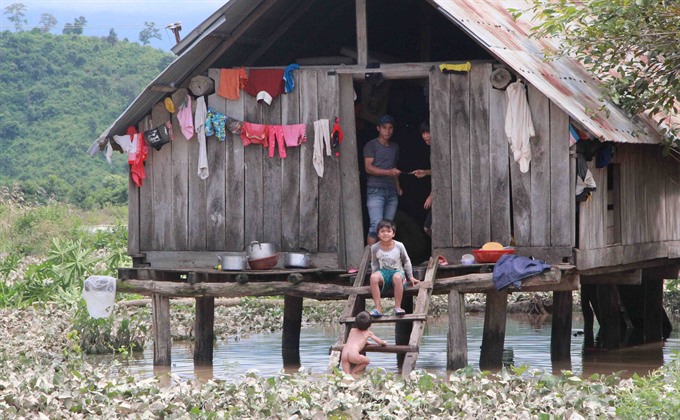

The health of children in Việt Nam has by and large recorded considerable improvements in recent years. However, these improvements disproportionately tend to occur in delta regions with better economic condition, while children in remote areas with a high concentration of ethnic minority groups continue to lag behind.
 |
| A house in Đắk Lắk Province. In 2016, 20.5 per cent of the province’s young children were under weight, and 31.7 per cent faced stunted growth. Three Central Highlands provinces - Đắk Lắk, Kon Tum and Gia Lai - posted the highest rate of malnourishment in Việt Nam. — VNA/VNS Photo Phạm Cường |
NORTHERN REGION — The health of children in Việt Nam has by and large recorded considerable improvements in recent years. However, these improvements disproportionately tend to occur in delta regions with better economic condition, while children in remote areas with a high concentration of ethnic minority groups continue to lag behind.
A study conducted between 2010 and 2015 by the National Institute of Nutrition (NIN), under the Ministry of Health, showed the ratio of underweight children (five-year-old or younger) has decreased from 17.5 per cent to 14.1 per cent, while the ratio of stunted children dropped from 29.3 to 24.6 per cent. In 2016, the national rates were 13.8 and 24.3 per cent, respectively.
However, in a number of areas with high concentrations of ethnic minority residents, such as the northern mountain region and Central Highlands, undernourishment continues to plague children, with one third suffering from stunted growth or underweight, nearly double the rate in delta regions, according to Prof. Trần Thành Đô from the NIN. In the six to 23-month period, the children in minority areas do not enjoy a full five food group diet and iron-rich food like red meat, he added.
The lack of clean water is also a major issue. According to Save the Children in Việt Nam (SC), the northern mountainous Yên Bái Province showed an alarming rate of stunted growth children at 69 per cent (2016 figure). The organisation also noted that women here do not usually wash hands before and after preparing meals for children, leading to high worm infection rates (40.52 per cent), and most water samples collected were deemed impure. These figures point to a likely correlation between the rate of malnourishment and other detrimental elements like water quality, worm infections, and pollution.
According to Prof. Nguyễn Thanh Tuấn from the Alive&Thrive project of the non-profit human development organisation FHI 360, the high rate of undernourishment in these areas can be attributed to poor nurturing practices. The organisation’s latest project in 11 provinces showed that the exclusive breastfeeding rate amongst ethnic people remains too low (4-33 per cent), and the rate of children enjoying appropriate diets in mountainous region hovers around half of those in flatlands (the former’s 33-52 per cent against the latter’s 75 per cent).
"Generally speaking, the reasons are due to low awareness amongst ethnic minority mothers and a severe lack of food security," Tuấn told Vietnam News Agency.
Differing practices among ethnic minority groups are also a problem. For example, Thái and Mường peoples have poor diets and incomplete meals, while Tày and Nùng people generally wean children off breastmilk too early, according to Tuấn.
NIN says the undernourishment and less than ideal physical health amongst ethnic minority groups will pose “long-term consequences” to the national workforce, and impede poverty reduction and economic development efforts in already underdeveloped areas. Therefore, the health ministry together with international organisations have implemented several programmes to help reduce child undernourishment and stunted growth, with more attention paid to ethnic groups. However, changing ingrained customs is not so easy.
Improvement efforts
Undernourishment in the northern mountainous province of Lào Cai is particularly high.
UNICEF (United Nations Children’s Fund) is therefore providing funding for the province to improve infant and young child feeding (IYCF) in Bản Phố Commune (Bắc Hà District) and Thào Chư Phìn Commune (Si Ma Cai District). The project covered 6,000 children, 700 of whom were found suffering from acute malnutrition. The underweight children were treated with nutritional products and an 85.5 per cent success rate was reported, each gaining an everage of 0.5-5kg after 6-12 weeks of treatment. However, the rest could not follow the nutrition regime or failed to show any improvements.
Thanks to the project, the rate of undernourishment in 5-year-old children and younger has decreased by 5 per cent compared to pre-intervention figure, and the rate of women knowing when to supplement child’s diet with food besides breastmilk has gone up by 20 per cent. Furthermore, the rate of exclusive breastfeeding in the first six months after birth has jumped 30 per cent, and the rate of childbirth with medical intervention by health workers is up 10 per cent. More importantly, the project has helped local mothers realise how to make best use of locally available food.
On a larger scale, to reduce food insecurity and undernourishment in the northern region (Lào Cai, Lai Châu and Hà Giang provinces), NIN launched a three-year project in November 2015 to build a supply chain of products in line with NIN’s nutrition standards. So far, an estimated 1,500 children from six to 24-months old and young mothers in nine targeted communes have benefitted from safe and nutritious food made from locally available ingredients, including a factory-produced porridge (rich in iron and zinc) and vegetable powder. The project also trains local nutritionists to help women accept and use products from these newly built factories.
Ass. Prof. Dr Trương Tuyết Mai, deputy head of NIN, said the institute is trying to address undernourishment by focusing efforts on the critical “1,000 golden days,” or the first 100-day window starting from pregnancy to the child’s 2nd birthday, as the nutrition during this period has “profound impacts” on children’s health and cognitive development.
Đào Lan Hương, senior health specialist from World Bank Việt Nam, recommended the country identify the root causes of malnutrition and devise appropriate strategies. The Vietnamese authorities also need to facilitate public access to safe and nutrious diets as well as clean water and find ways to reduce the work burden for women. — VNS




